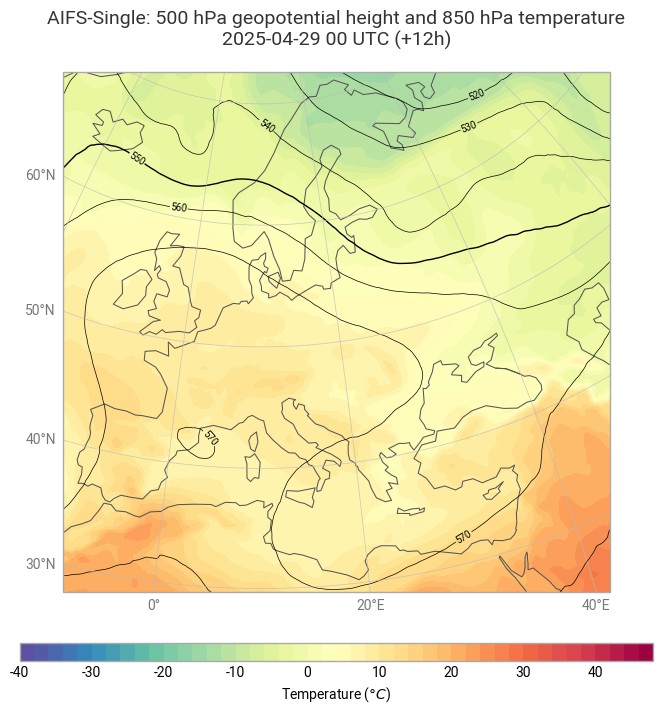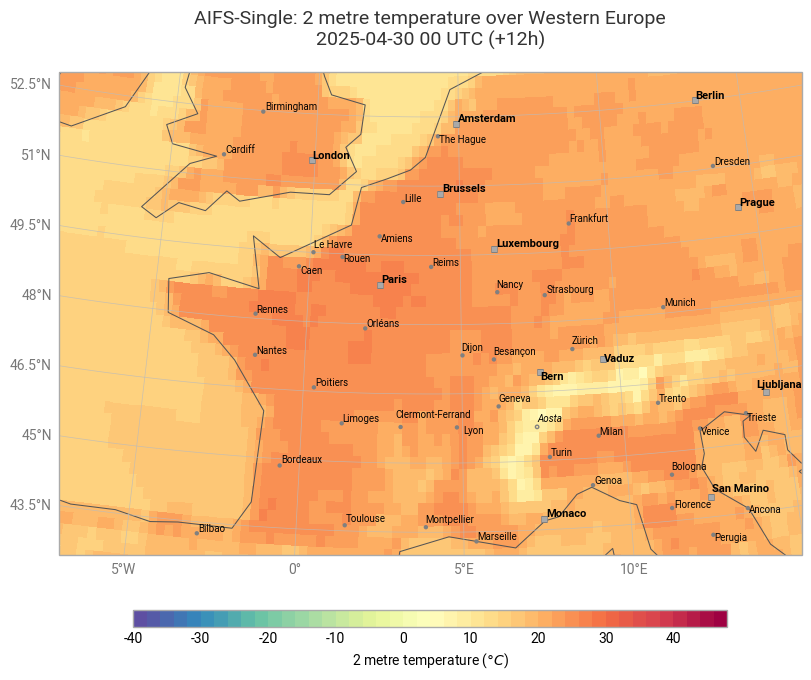In the end of April 2025, Western European countries experienced unseasonably warm weather. This example shows analysis of the selected parameters:
zgeopotential at constant pressure level 500 hPa,ttemperature at 850 hPa, and2t2 metre temperature of the AIFS-Single datasets on 30 April at 12 UTC in France (48.3° N, 4.1° E).
1. Set Up Your Environment and Find ECMWF Open Data¶
Open data will be downloaded from a publicly available Amazon S3 Bucket. First, the following Python libraries need to be installed in the current Jupyter kernel:
ecmwf-opendatato download data andearthkitto analyse and plot the data.
If the packages are not installed yet, uncomment the code below and run it.
# !pip3 install earthkit ecmwf-opendatafrom ecmwf.opendata import Client
import earthkit.data as ekd
import earthkit.plots as ekp
import earthkit
import osList of parameters to retrieve from open datasets¶
The selected values below can be modified.
Parameters available on pressure levels:
PARAM_PL = ["z", "t"]
LEVELS = [500, 850]
LEVELTYPE = "pl"
DATES = [20250429, 20250430, 20250501]
TIME = 0
STEPS = 12
STREAM = "oper"
TYPE = "fc"
MODEL = "aifs-single"Parameters available on a single level:
PARAM_SFC = ["2t"]
LEVELTYPE = "sfc"
DATES = [20250429, 20250430, 20250501]
TIME = 0
STEPS = 12
STREAM = "oper"
TYPE = "fc"
MODEL = "aifs-single"Data and plots directories¶
DATADIR = './data_dir/'
os.makedirs(DATADIR, exist_ok=True)
PLOTSDIR = './plots/'
os.makedirs(PLOTSDIR, exist_ok=True)Get the data using the ECMWF Open Data API¶
def get_open_data(date, time, step, stream, _type, model, param, leveltype, levelist=[]):
client = Client(source="aws")
list_of_files = []
# Get the data for all dates
for _date in DATES:
filename = f"{DATADIR}{model}_{''.join(param)}_{''.join(map(str, levelist))}_{_date}.grib2" if levelist else f"{DATADIR}{model}_{''.join(param)}_{leveltype}_{_date}.grib2"
data = client.retrieve(
date=_date,
time=time,
step=step,
stream=stream,
type=_type,
levtype=leveltype,
levelist=levelist,
param=param,
model=model,
target=filename
)
list_of_files.append(filename)
return data, list_of_files2. Geopotential at 500 hPa and temperature at 850 hPa¶
When using the ls() method, a list of all the fields in the file we downloaded will be displayed.
data, list_of_files = get_open_data(date=DATES,
time=TIME,
step=STEPS,
stream=STREAM,
_type=TYPE,
model=MODEL,
param=PARAM_PL,
leveltype=LEVELTYPE,
levelist=LEVELS)
# Select AIFS model data from 29 April 2025
ds = ekd.from_source("file", list_of_files[0])
ds.ls()Only the parameters and their levels which we specified above will be returned when we apply the sel() function.
t850 = ds.sel({"level": 850, "shortName": "t"})
t850.ls()In the cell below, the geopotential on 500 hPa will be selected and a new fieldlist with a single field containing the new values and metadata will be created.
z500 = ds.sel({"level": 500, "shortName": "z"})[0]
z500.ls()Geopotential height is calculated by dividing the geopotential by the Earth’s mean gravitational acceleration, g (=9.80665 m s-2). In the ECMWF Open Charts, it is plotted in geopotential decameters. Therefore, our result also need to be divided by 10.
ds_gh500 = z500.values / (9.80665 * 10)To change metadata values, put key value pairs to the override() function.
md_gh500 = z500.metadata().override(shortName="gh")
md_gh500["shortName"], md_gh500["level"]('gh', 500)When using the head() method, a selected number of rows n and information about the fields in the file we downloaded will be displayed.
gh500 = ekd.FieldList.from_array(ds_gh500, md_gh500)
gh500.head()data, list_of_files = get_open_data(date=DATES,
time=TIME,
step=STEPS,
stream=STREAM,
_type=TYPE,
model=MODEL,
param=PARAM_SFC,
leveltype=LEVELTYPE,
levelist=[])
# Select data from 30 April 2025
ds_2t = ekd.from_source("file", list_of_files[1])
ds_2t.ls()There is no need to convert temperature from Kelvin to Celsius, because in the earthkit-plots library we can set units of it.
t2m = ds_2t.sel(shortName="2t")
t2m.ls()4. Data visualisation¶
The plot below shows analysis of T850 and z500 on 29 April 2025.
chart = ekp.Map(domain="Europe")
t850_shade = ekp.styles.Style(
colors="Spectral_r",
levels=range(-40, 50, 2),
extend="both",
units="celsius",
)
chart.contourf(t850, style=t850_shade)
chart.contour(gh500,
levels={"step": 10, "reference": 550},
linecolors="black",
linewidths=[0.5, 1, 0.5, 0.5],
labels = True,
legend_style = None,
transform_first=True)
chart.coastlines(resolution="low")
chart.gridlines()
chart.legend(location="bottom", label="{variable_name} ({units})")
chart.title(
"AIFS-Single: 500 hPa geopotential height and 850 hPa temperature\n"
"{base_time:%Y-%m-%d %H} UTC (+{lead_time}h)\n",
fontsize=14, horizontalalignment="center",
)
chart.save(f"{PLOTSDIR}{''.join(PARAM_PL)}_{MODEL}_{DATES[0]}{TIME}-{STEPS}h.png")
chart.show()
The plot below shows analysis of 2 metre temperature on 30 April at 00 UTC.
chart = ekp.Map(domain=[-7, 15, 43, 53])
t2m_shade = ekp.styles.Style(
colors="Spectral_r",
levels=range(-40, 50, 2),
extend="both",
units="celsius",
)
chart.grid_cells(t2m, style=t2m_shade)
chart.title(
"AIFS-Single: {variable_name} over Western Europe\n"
"{base_time:%Y-%m-%d %H} UTC (+{lead_time}h)\n",
fontsize=14, horizontalalignment="center",
)
chart.coastlines(resolution="low")
chart.gridlines()
chart.cities(adjust_labels=True)
chart.legend(location="bottom", label="{variable_name} ({units})")
chart.save(f"{PLOTSDIR}{''.join(PARAM_SFC)}_{MODEL}_{DATES[1]}{TIME}-{STEPS}h.png")
chart.show()